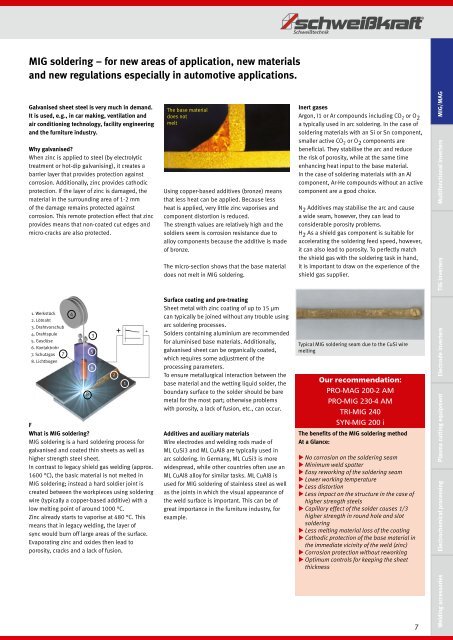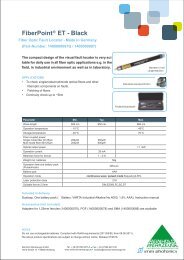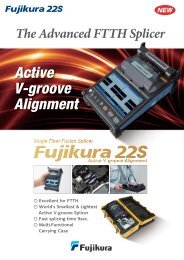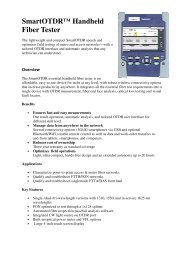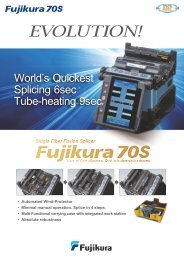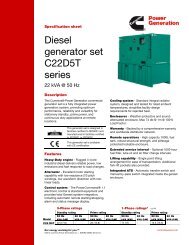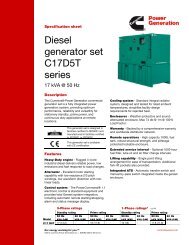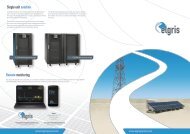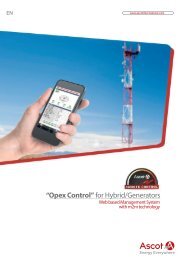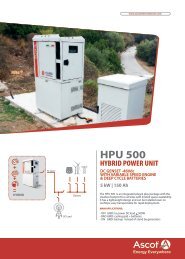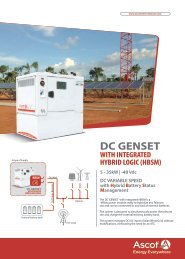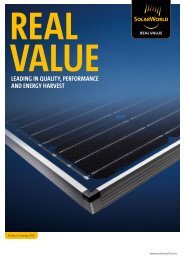EN welding technology
You also want an ePaper? Increase the reach of your titles
YUMPU automatically turns print PDFs into web optimized ePapers that Google loves.
MIG soldering – for new areas of application, new materials<br />
and new regulations especially in automotive applications.<br />
Grinding<br />
Galvanised sheet steel is very much in demand.<br />
It is used, e.g., in car making, ventilation and<br />
air conditioning <strong>technology</strong>, facility engineering<br />
and the furniture industry.<br />
Why galvanised?<br />
When zinc is applied to steel (by electrolytic<br />
treatment or hot-dip galvanising), it creates a<br />
barrier layer that provides protection against<br />
corrosion. Additionally, zinc provides cathodic<br />
protection. If the layer of zinc is damaged, the<br />
material in the surrounding area of 1-2 mm<br />
of the damage remains protected against<br />
corrosion. This remote protection effect that zinc<br />
provides means that non-coated cut edges and<br />
micro-cracks are also protected.<br />
1. Werkstück<br />
2. Lötnaht<br />
3. Drahtvorschub<br />
4. Drahtspule<br />
5. Gasdüse<br />
6. Kontaktrohr<br />
7. Schutzgas 7<br />
8. Lichtbogen<br />
4<br />
8<br />
+ -<br />
F<br />
What is MIG soldering?<br />
MIG soldering is a hard soldering process for<br />
galvanised and coated thin sheets as well as<br />
higher strength steel sheet.<br />
In contrast to legacy shield gas <strong>welding</strong> (approx.<br />
1600 °C), the basic material is not melted in<br />
MIG soldering; instead a hard soldier joint is<br />
created between the workpieces using soldering<br />
wire (typically a copper-based additive) with a<br />
low melting point of around 1000 °C.<br />
Zinc already starts to vaporise at 480 °C. This<br />
means that in legacy <strong>welding</strong>, the layer of<br />
sync would burn off large areas of the surface.<br />
Evaporating zinc and oxides then lead to<br />
porosity, cracks and a lack of fusion.<br />
3<br />
5<br />
6<br />
2<br />
1<br />
The base material<br />
does not<br />
melt<br />
Using copper-based additives (bronze) means<br />
that less heat can be applied. Because less<br />
heat is applied, very little zinc vaporises and<br />
component distortion is reduced.<br />
The strength values are relatively high and the<br />
soldiers seem is corrosion resistance due to<br />
alloy components because the additive is made<br />
of bronze.<br />
The micro-section shows that the base material<br />
does not melt in MIG soldering.<br />
Surface coating and pre-treating<br />
Sheet metal with zinc coating of up to 15 µm<br />
can typically be joined without any trouble using<br />
arc soldering processes.<br />
Solders containing aluminium are recommended<br />
for aluminised base materials. Additionally,<br />
galvanised sheet can be organically coated,<br />
which requires some adjustment of the<br />
processing parameters.<br />
To ensure metallurgical interaction between the<br />
base material and the wetting liquid solder, the<br />
boundary surface to the solder should be bare<br />
metal for the most part; otherwise problems<br />
with porosity, a lack of fusion, etc., can occur.<br />
Additives and auxiliary materials<br />
Wire electrodes and <strong>welding</strong> rods made of<br />
ML CuSi3 and ML CuAl8 are typically used in<br />
arc soldering. In Germany, ML CuSi3 is more<br />
widespread, while other countries often use an<br />
ML CuAl8 alloy for similar tasks. ML CuAl8 is<br />
used for MIG soldering of stainless steel as well<br />
as the joints in which the visual appearance of<br />
the weld surface is important. This can be of<br />
great importance in the furniture industry, for<br />
example.<br />
Inert gases<br />
Argon, I1 or Ar compounds including CO 2 or O 2<br />
a typically used in arc soldering. In the case of<br />
soldering materials with an Si or Sn component,<br />
smaller active CO 2 or O 2 components are<br />
beneficial. They stabilise the arc and reduce<br />
the risk of porosity, while at the same time<br />
enhancing heat input to the base material.<br />
In the case of soldering materials with an Al<br />
component, Ar-He compounds without an active<br />
component are a good choice.<br />
N 2 Additives may stabilise the arc and cause<br />
a wide seam, however, they can lead to<br />
considerable porosity problems.<br />
H 2 As a shield gas component is suitable for<br />
accelerating the soldering feed speed, however,<br />
it can also lead to porosity. To perfectly match<br />
the shield gas with the soldering task in hand,<br />
it is important to draw on the experience of the<br />
shield gas supplier.<br />
Typical MIG soldering seam due to the CuSi wire<br />
melting<br />
Our recommendation:<br />
PRO-MAG 200-2 AM<br />
PRO-MIG 230-4 AM<br />
TRI-MIG 240<br />
SYN-MIG 200 i<br />
The benefits of the MIG soldering method<br />
At a Glance:<br />
XXNo corrosion on the soldering seam<br />
XXMinimum weld spatter<br />
XXEasy reworking of the soldering seam<br />
XXLower working temperature<br />
XXLess distortion<br />
XXLess impact on the structure in the case of<br />
higher strength steels<br />
XXCapillary effect of the solder causes 1/3<br />
higher strength in round hole and slot<br />
soldering<br />
XXLess melting material loss of the coating<br />
XXCathodic protection of the base material in<br />
the immediate vicinity of the weld (zinc)<br />
XXCorrosion protection without reworking<br />
XXOptimum controls for keeping the sheet<br />
thickness<br />
Electrochemical processing Plasma cutting equipment Electrode inverters<br />
TIG inverters<br />
Multifunctional inverters MIG/MAG<br />
7<br />
Welding accessories


